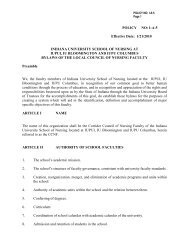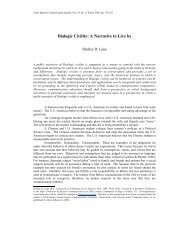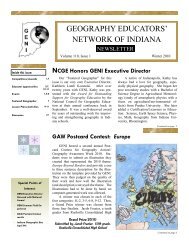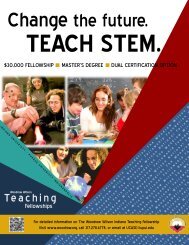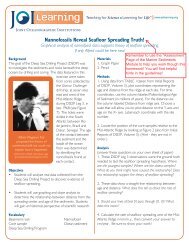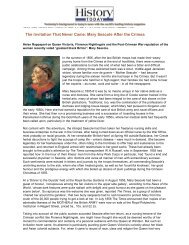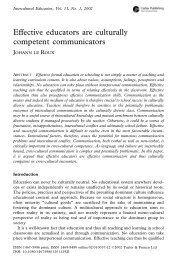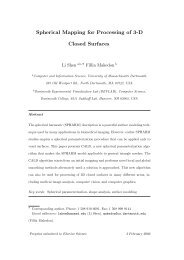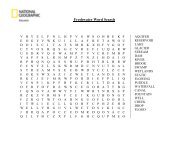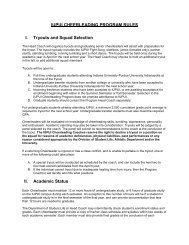Incorporate diversity into your classroom - IUPUI
Incorporate diversity into your classroom - IUPUI
Incorporate diversity into your classroom - IUPUI
You also want an ePaper? Increase the reach of your titles
YUMPU automatically turns print PDFs into web optimized ePapers that Google loves.
20 W AYS T O . . .<br />
<strong>Incorporate</strong> Diversity Into<br />
Your Classroom<br />
TYI-SANNA JONES<br />
ries of Holy Days/holidays, arts, dress, food,<br />
music, history—what defines the people of the<br />
country. Let us briefly use this approach to<br />
study India across the curriculum.<br />
Diversity is more easily incorporated <strong>into</strong> the <strong>classroom</strong><br />
through careful planning. The 20 examples provided<br />
here are intended to serve as a springboard for ideas you<br />
can implement in <strong>your</strong> <strong>classroom</strong>. In our increasingly diverse<br />
world, a global perspective will reinforce to children<br />
and young adults that we cannot afford to function<br />
in the comfort of our communities without acknowledging<br />
other religions, philosophies, traditions, and languages.<br />
Thus, using a worldly perspective facilitates and models<br />
tolerance. The examples here are provided for both primary<br />
and secondary educators.<br />
1.<br />
Use countries as thematic units. Individual<br />
countries may serve as monthly themes.<br />
While studying the country, you can focus on<br />
the religions, language, monetary system, se-<br />
• Art: Glass/colorful beads:<br />
Primary level: String or sew beads onto<br />
colorful material to make a wall hanging.<br />
Secondary level: Make and decorate a silk<br />
pillow. Use plastic mirrors, glass beads, and<br />
colorful embroidery to decorate.<br />
• History/Government:<br />
- India’s government in the last 60 years<br />
- The caste system<br />
• Religion:<br />
- Hindu, Muslim, Buddhist<br />
- Striving toward democracy<br />
• Science: Use the Internet to explore vegetation<br />
and crops that are native to India.<br />
• Reading/English: Read a book/novel<br />
about an Indian child/young adult.<br />
• Music: Listen to traditional ghazals and<br />
tabla music and compare it to the more<br />
modern styles listened to by Indian youth<br />
today.<br />
• Physical education: Learn basic belly<br />
dancing techniques and learn to play<br />
cricket.<br />
• Math: Learn about the monetary system.<br />
Compare it to the system we use in United<br />
States; also, study exchange rates and the<br />
Indian stock market.<br />
INTERVENTION IN SCHOOL AND CLINIC VOL. 41, NO. 1,SEPTEMBER 2005 (PP. 9–12) 9
2.<br />
3.<br />
During the various seasons and U.S.<br />
holidays share information about<br />
Holy Days and holidays around the<br />
world. When several Holy Days/holidays<br />
occur approximately at the same time, use<br />
compare and contrast activities to show similarities<br />
and differences (i.e., the Kinara and<br />
the Menorah, from Kwanzaa and Hanukkah,<br />
respectively).<br />
Study world explorers. During lessons<br />
involving world explorers, include a project<br />
researching African, Mexican, Indian, and<br />
Norwegian explorers in addition to the typical<br />
lessons on Spanish, English, and Portuguese<br />
world explorers.<br />
7.<br />
8.<br />
Assign art projects using traditional<br />
art around the world as examples.<br />
For example, if the activity is studying patterns<br />
and use of color, the teacher may use examples<br />
from Sioux, Celtic, Burmese, and Massa<br />
peoples.<br />
Have students interview their families<br />
to explore their lineage, native<br />
language, and family history. Students<br />
can present their findings using a project<br />
display that may include family tree, information<br />
about the native language, interesting<br />
family facts, pictures, and written family<br />
history.<br />
4.<br />
Use a variety<br />
of coloring<br />
books/movies/<br />
materials<br />
that reflect<br />
the population<br />
of <strong>your</strong><br />
school and<br />
community.<br />
If there is no <strong>diversity</strong><br />
within<br />
<strong>your</strong> school, still<br />
use a variety of materials for exposure. Be<br />
careful <strong>your</strong> selections are not offensive to<br />
the groups that you are representing. See<br />
http://www.justlikemebooks .com, Happily<br />
Ever After series by HBO (http://www<br />
.hbofamily.com/programs/jam/happily_<br />
ever_after.htm), African Bookstore (http://<br />
www.africanbookstore.com), and http://www<br />
.kstrom.net/isk/books/children.html.<br />
9.<br />
10.<br />
Use music to stimulate the interest<br />
of <strong>your</strong> students. Select a certain day of<br />
the week where a student brings in a selection<br />
of music for the class to hear. The student is<br />
asked to discuss the style and history of the<br />
musician, singer, or rapper. Be very clear<br />
about <strong>your</strong> expectations and the appropriateness<br />
of the selection. Challenge young people<br />
to go beyond artists found on MTV, BET, and<br />
VH-1.<br />
During the sharing of music, chart<br />
music by genre (e.g., gospel, pop, hiphop,<br />
reggae, ska, souka, country, opera, salsa,<br />
classical, rock and roll). Use charts to compare<br />
instruments, beats, tempo, falsetto, concerto,<br />
and so on. Using music like this encourages<br />
students to learn the musical concepts you<br />
want them to learn through what they already<br />
know. Introduce other genres that may be new<br />
to you and the students.<br />
5.<br />
6.<br />
Select textbooks and supplemental<br />
books that reflect culture, gender,<br />
and <strong>diversity</strong> within the world. Books<br />
should include children of different cultures,<br />
religions, disabilities, socioeconomic levels,<br />
gender preferences, and race.<br />
Subscribe to magazines, comic<br />
books, and journals that reflect the<br />
population of <strong>your</strong> students (e.g.,<br />
Black Enterprise, Latina, Teen Beat, Spawn).<br />
11.<br />
Study the history of written<br />
language. As part of a handwriting activity,<br />
explore different mediums of paper, pens, and<br />
writing styles<br />
throughout the<br />
world and<br />
across time:<br />
calligraphy<br />
(Western and<br />
Eastern), hieroglyphics,<br />
and Braille.<br />
10 INTERVENTION IN SCHOOL AND CLINIC
12.<br />
13.<br />
Reinforce the<br />
culture being<br />
studied. Start<br />
simple. A special<br />
Friday activity<br />
could be to make<br />
cookies or follow<br />
a simple recipe<br />
from the culture<br />
being studied.<br />
The obvious<br />
goal is to taste<br />
different snacks<br />
from around the<br />
world, but this<br />
will intertwine with math concepts of measuring,<br />
social and functionally based skills such as<br />
following directions, sharing, setting the<br />
table, table etiquette, and manners.<br />
Study and compare world fashion.<br />
Use magazines and pr<strong>into</strong>uts from the Internet<br />
to check out the trendiest fashions around<br />
the world. Through <strong>your</strong> study of cultures,<br />
find the roots of these new fashions. The<br />
runways each season are full of cultural<br />
blending.<br />
16.<br />
17.<br />
Research the most popular pets<br />
around the world. Each student identifies<br />
five countries using an atlas. Through the use<br />
of Web sites, pen pals, or e-pals, students explore<br />
popular pets in respective countries.<br />
After conducting research on a country, the<br />
student makes a hypothesis about what kind<br />
of animals he or she believes will be popular.<br />
The student will design a 5 + questionnaire<br />
to collect data. Questions included will determine<br />
whether the person lives in an urban or<br />
rural area, if he or she has a pet, how many,<br />
what kind, and his or her dream pet. Students<br />
will complete the study using the entire scientific<br />
method and provide graphs and present<br />
project to class. Class members may combine<br />
findings and make class graphs.<br />
Study marriage customs. Looking at<br />
arranged marriages, dowry, bride price, and<br />
the dating systems, have students compare<br />
and contrast traditions, discuss what they<br />
think they would prefer, and how these systems<br />
affect relationships between genders<br />
and the families involved. A variety of videos,<br />
books, short stories, poems, magazines, and<br />
novels may be used to collect information.<br />
14.<br />
15.<br />
Use the Internet, books, and<br />
magazines like National Geographic,<br />
to get an international perspective.<br />
Have students identify a kind of home they<br />
would like to research. Students will discuss<br />
the materials used, where homes like this<br />
would be made, how many people would live<br />
in it, the heating/cooling system, its mobility,<br />
and its upkeep.<br />
Study family units. What makes a<br />
family? While reading stories/novels about<br />
various cultures, record the members of the<br />
families and their function within the family<br />
unit and use them to make family trees.<br />
Compare and contrast nuclear families and<br />
extended families. Recognize how the family<br />
name is carried from either the paternal or<br />
maternal side. Have students make a family<br />
tree of their own families. Encourage the inclusion<br />
of family friends and godparents who<br />
may be considered family.<br />
18.<br />
19.<br />
Study hair styles and discuss<br />
the scientific reasons people of<br />
different ethnicities have different<br />
textures of hair. Look at the regions<br />
to which people have migrated, the climates,<br />
and the function of hair. Look at traditions<br />
and styles developed in many cultures around<br />
hair, today’s styles, and daily and weekly<br />
maintenance<br />
for hair of<br />
different<br />
textures.<br />
Study<br />
games<br />
across the<br />
world.<br />
What do kids<br />
do for fun?<br />
Have students<br />
explore<br />
games that<br />
are popular<br />
VOL. 41, NO. 1,SEPTEMBER 2005 11
20.<br />
around the world, such as cricket, soccer,<br />
rugby, red rover, double Dutch, and foursquare.<br />
While reading novels and books, you<br />
and <strong>your</strong> students will come across names of<br />
games that you may never have heard of.<br />
If they sound like fun, check the Internet for<br />
rules; if you are lucky, the rules may be explained<br />
right in the book.<br />
Go on field trips!! Take advantage of cultural<br />
activities in <strong>your</strong> town or nearby cities.<br />
Get <strong>your</strong> kids out! Organize trips to larger<br />
cities where ballets, theatre troupes, and symphonies<br />
visit. Expose <strong>your</strong> students to mainstream<br />
culture within the United States, as<br />
well as subcultures of the Unites States and<br />
the world. Create a sister school within the<br />
state, with an urban and a rural school as partners.<br />
This allows kids who are growing up in<br />
different cultures or regions to learn more<br />
about each other. Extension ideas may include<br />
taking field trips together, overnight camping,<br />
and team-building activities. Sister schools<br />
that are farther away may begin the relationship<br />
with pen pal and exchange student programs.<br />
Remember that when working with<br />
<strong>your</strong> sister school that you are equal partners.<br />
Do not approach a school or teacher in a different<br />
area as if they need you or that <strong>your</strong><br />
ideas are superior.<br />
Options for these kinds of activities are only limited<br />
by the walls of <strong>your</strong> own mind. Set the standards high for<br />
<strong>your</strong> students’ success; prepare them to respond to new<br />
ideas, sights, and values. Be open and expect <strong>your</strong> students<br />
to embrace <strong>diversity</strong>. Remember: If you don’t believe<br />
in it, they won’t either!<br />
ABOUT THE AUTHOR<br />
Tyi-Sanna Jones, MS, is enrolled in a doctoral program in special<br />
education with an emphasis on autism and gifted education<br />
at the University Nevada, Las Vegas. Her research interests include<br />
the overrepresentation of African Americans and Hispanic<br />
children in special education and the effectiveness of current<br />
programs for children with autism. E-mail: Jonest22@unlv<br />
.nevada.edu<br />
Linking IEPs to State Learning Standards:<br />
A Step-By-Step Guide<br />
This guide was developed to address the IDEA mandate to<br />
link students' Individualized Education Programs with state<br />
learning standards. Although almost all 50 states have created<br />
drafts or final versions of learning standards, few have<br />
developed the supports and procedures necessary to ensure<br />
that those standards are used to design students' IEPs. This<br />
step-by-step guide will assist teachers in dealing with the challenges<br />
presented by connecting IEPs to state learning standards,<br />
and show them how to align their students' education<br />
with the general curriculum. Special education administrators,<br />
special educators, and IEP team members will find this<br />
guide to be an invaluable resource. Major features of this<br />
book include:<br />
• background information regarding state learning<br />
standards and their relationship to IEPs<br />
• relevant rules and regulations from the 1997 IDEA statute<br />
Lynda Miller and Lauren Hoffman<br />
• step-by-step procedures<br />
for becoming familiar with<br />
state learning standards, discovering<br />
how a curriculum<br />
is related to those standards,<br />
and designing IEPs based on<br />
standards<br />
• examples showing how to<br />
use this step-by-step process<br />
effectively and efficiently<br />
• helpful resources for<br />
practitioners<br />
• reproducible forms<br />
57 pages, 2002 ISBN 0-89079-884-2<br />
#9323, paperback $20.00<br />
PRO-ED, Inc. • 8700 Shoal Creek Blvd. • Austin, Texas 78757-6897 • ph 800/897-3202 or<br />
512/451-3246 • fax 800/FXPROED • All PRO-ED products are sold on a 30-day approval.<br />
Shipping and handling: U.S. add 10%, Canada add 15%, others add 20%.<br />
12 INTERVENTION IN SCHOOL AND CLINIC



